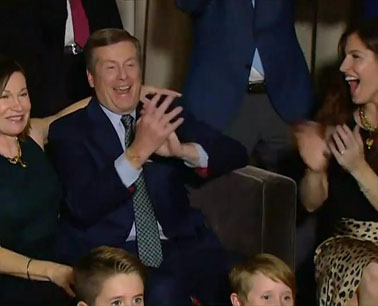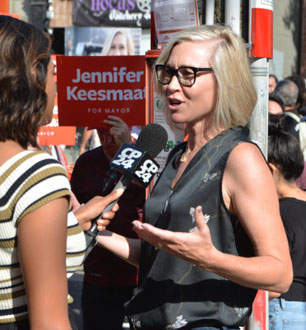On the 2018 Toronto election … “it could be worse” seems the best you can say?
Oct 29th, 2018 | By Randall White | Category: In Brief
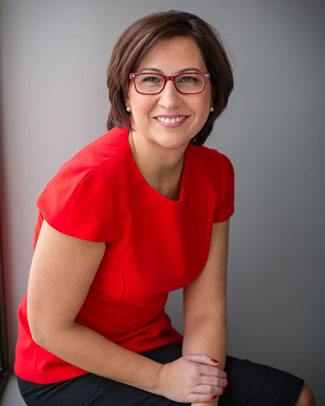
Councillor Ana Bailão, who grew up “in the rich cultural diversity of the Davenport area,” and studied at West Toronto Collegiate and the University of Toronto, appeared as deputy mayor at John Tory’s first press conference of his second term as Mayor of Toronto. A city councillor since 2010 Ms Bailão also won more than 83% of the 2018 vote in the new Ward 9 : Davenport.
The day itself was an entire week ago now, but no matter …
The drama of the 2018 municipal election in Canada’s current largest city was all before election day.
The somewhat Trumpian Doug Ford, new premier of Canada’s most populous province of Ontario (and failed Toronto mayoral candidate in 2014), finally managed to reduce the size of city council from 44 to 25 members, in the middle of the campaign!
His quest may have had its moments – notwithstanding an ultimately unnecessary appeal to the fabled “notwithstanding clause” in Canada’s Constitution Act, 1982.
In the end, however, it just set the stage for a traditionally boring municipal election – nicely summarized in Denise Balkissoon’s Globe and Mail report, “Meet the new Toronto Council, same as the old Toronto Council.”
(And in the Toronto Star see Edward Keenan’s “Toronto’s new council has as many ‘Michaels’ as visible minorities.”)
To start with, reducing the size of council seems to have strengthened the local political system’s longstanding bias towards incumbents – those who have already served on council, and whose names are well enough known among the traditional minority of the electorate who vote.
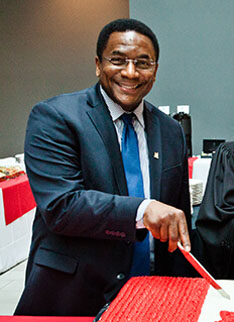
Michael Thompson from Scarborough cuts Canadian flag cake at citizenship ceremony in Toronto, February 19, 2014. A longtime conservative councillor (since 2003), he returned as both one of the four “people of colour” and one of the four Michaels on the slimmed down 25-member Toronto City Council of 2018.
After the 2018 election in Toronto there are only “four new faces on a 25-member council.” For further intelligence see “Rookies on Toronto city council could hold balance of power” in the Toronto Star, by Jennifer Pagliaro, David Rider, and Samantha Beattie.
The same Star piece also notes : “Looking at previous vote records and past allegiances on council, it appears there are 10 very reliable votes for [now re-elected Mayor John] Tory, including his own, and seven stalwart progressives. The rest are somewhere in the middle …”
A bare majority on the new 25-member council (plus one mayor = 26) is 14. Graphic material at the end of the Pagliaro-Rider-Beattie report in the Toronto Star notes that, strictly speaking there are now 20 “incumbents” and five “new councillors.”
(Shelley Carroll in “Ward 17 – Don Valley North” – resigned her earlier council seat to run unsuccessfully in this past June’s Ontario provincial election. So she technically qualifies as a “new councillor.” But : “Prior to her provincial bid, she represented the former Ward 33 on city council [Don Valley East] for 15 years.”)
The same Star graphic material divides the new 25-member council ideologically into 12 “right councillors”, nine “left councillors”, and four “unknown”.
As a further sign of just how much the present is trapped in the past, the “unknown” on this reading are the otherwise designated “new councillors” above, less Shelley Carroll.
(And even here the four “new faces” – as still further above – include Mike Colle. He is a former member of the Ontario provincial parliament at Queen’s Park, and before that a municipal politician in the old local federalist days of Metro Toronto. He has now successfully run to replace his retiring son Josh Colle, on the current amalgamated City of Toronto council. )
I have four further quick notes to add on all this : (1)Â Voter turnout in 2018 and 2014 … a tale of two quite different city elections ; (2) When will the “new very diverse Toronto in the inner suburbs” show up on city council? ; (3) NOW magazine and Jennifer Keesmaat as a winner anyway ;Â (4) Finally getting John Tory’s ancestry right … he’s not really descended from the early 19th century Family Compact or even the mid 19th century Tory Toronto Charles Dickens found so “appalling” … but the mayor’s great grandfather (it seems) did welcome Winston Churchill to Toronto in 1929, not long before the historic great stock market crash in New York.
Those who may want to pursue these matters still further can click on “Read the rest of this page” and/or scroll below!
(1)Â Voter turnout in 2018 and 2014
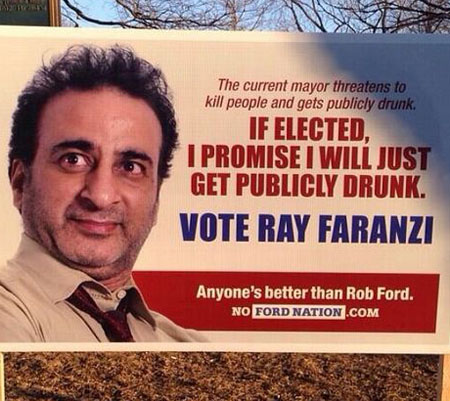
Satirical election sign from 2014 campaign – “Anyone’s better than Rob Ford”. (And the anyone turned out to be John Tory!)
Some more detailed official election results from the City of Toronto are still “coming soon.” In round numbers, however, initial unofficial results put 2018 voter turnout at about 41% of the registered electorate.
This is down a lot from the 60% of 2014 or even the 51% of 2010 . But it is also close to the 43%Â city-wide voter turnout average across all three Toronto municipal elections of 2003, 2006 and 2010. (And close enough as well to the 43% average voter turnout for all municipal elections across Ontario in 2014.)
The 2014 Toronto election focussed on an unusually competitive mayoralty race, in the immediate wake of former Mayor Rob Ford’s troubled administration. The 60% municipal turnout that year was higher than in the 2014 Ontario provincial election (51%) – or even the most recent Ontario election of this past June (58%).
The 2010 Toronto election also involved an unusually competitive mayoralty race that the rising right-wing populist Rob Ford finally won, to much surprise. (A kind of local prelude to Donald Trump in the USA of 2016, and Doug Ford in Ontario in 2018.) In 2018 the city has apparently reverted to earlier less dramatic local norms.
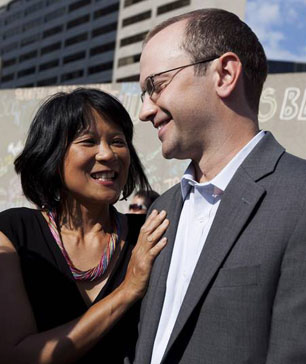
Olivia Chow with her stepson, Toronto councillor Mike Layton, summer 2012. Another stalwart progressive, the son of the late former federal New Democratic leader Jack Layton was also easily re-elected in 2018 for Ward 11 — University-Rosedale, with just shy of 70% of the total riding vote.
In 2014 John Tory was the former Ontario Progressive Conservative leader who managed to defeat both the more aggressively right-wing populist heir of Rob Ford, elder brother Doug Ford, and the more aggressively left-wing progressive (and widow of former federal NDP leader Jack Layton), Olivia Chow.
The 2014 election was a referendum on the future of the Ford Nation in Toronto city politics. John Tory proved the more moderate guy who could slay the dragon, with 40.3% of the city-wide vote (compared to 33.7% for Doug Ford and 23.2% for Ms Chow).
In 2018 all the opinion polls beforehand had shown the (somewhat) more moderate dragonslayer of 2014 would easily win again – and he did, with 63.5% of the city-wide vote (compared to 23.6% for his nearest challenger, former chief city planner Jennifer Keesmaat).
Whatever else, the tradition of boring elections in Toronto municipal politics (and subsequent boring city governments – remember eg the long and maybe happy age of Mayor Art Eggleton, 1980—1991) has apparently returned in 2018.
Some will say this is a good thing. Others will not.
In either case life will go on, in some kind of orderly manner. And that probably is what the majority of the 41% who voted in 2018 would like to see … more or less (and again maybe??).
(2) When will the “new very diverse Toronto in the inner suburbs” show up on city council?
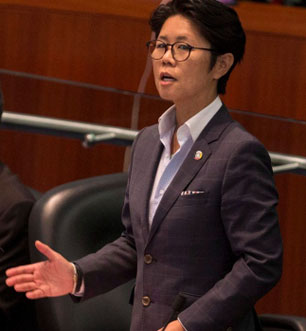
Councillor Kristyn Wong-Tam introduces a motion during debate on Ontario Government's legislation to reduce the size of Toronto City Council, on Thursday September 13, 2018. THE CANADIAN PRESS/Chris Young. She returned to the reduced Council as the member for Ward 13 — Toronto Centre on October 22.
Both Denise Balkissoon and Edward Keenan (see above) have expressed reasonable concerns about how even though “51 per cent of Torontonians identify as visible minorities” as of the 2016 census, there were only “four people of colour elected to the new city council” in 2018.
Moreover, the “15 per cent of council represented by visible minorities these four councillors make up actually sets a record high” in Toronto municipal elections.
One side of all this is that democratic city politics has traditionally been about, say, 30 years behind the evolving urban society it ought to ultimately reflect.
In his now ancient study Urban Political Systems : A Functional Analysis of Metro Toronto the political scientist Harold Kaplan noted long ago that the “Metro political elite” of the early 1960s, eg, “represented less the Toronto of 1962 than the Toronto of 1932 – a tightly integrated, socially homogeneous, middle-class community, dedicated to the Crown and Empire, the Conservative Party, the Toronto Telegram, the Anglican Church, temperance, and Sunday blue laws … Under-represented … were Catholics, Italians, and eastern Europeans …”
The Toronto political elite elected to the 2018 city council might similarly be said to better represent the local urban scene of 1988, when “visible minorities” and “people of colour” were still not in even a bare demographic majority – but “Catholics, Italians, and eastern Europeans” were starting to stroll the local corridors of political power at last.
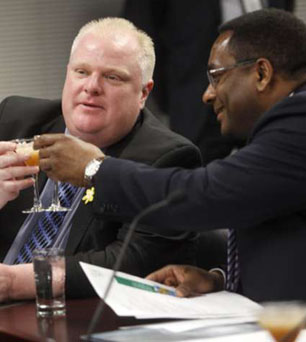
Mayor Rob Ford and Councillor Michael Thompson toast the 50th anniversary of the independence of Jamaica, Tuesday April 12, 2011 in Toronto.
When will the new Toronto that now embraces the wider global village of East Asia, South Asia, and Africa (north and south) as well as Europe beyond the United Kingdom – and that is increasingly lodged in the old “inner suburbs” of Etobicoke, East York, and Scarborough –Â move beyond the narrow world of Denzil Minnan-Wong, Michael Thompson, Kristyn Wong-Tam, and newcomer Cynthia Lai?
Shawn Micallef has already offered an early look at the struggles of the new very diverse Toronto now putting down deep roots in the old inner suburbs to build political muscles commensurate with its new demographic strength, in his lively 2016 study, Frontier City : Toronto on the Verge if Greatness. (I don’t personally believe Toronto is on the verge of greatness exactly, whatever that may mean nowadays, but Mr. Micallef has nonetheless written an interesting book!)
What the 2018 election has shown is that these struggles are still some distance from any major political fruition. (And reducing the size of city council from 44 to 25 members has almost certainly lengthened the time before any such fruition finally arrives in any full-blown form?)
(3) NOW magazine and Jennifer Keesmaat as a winner anyway
Ever since longtime editor and publisher Alice Klein announced that Toronto’s NOW Magazine will no longer carry sex ads in the back of its hard-copy printed edition (as of this past September 6), it has somehow seemed to me a more politically credible publication.
In some similar (if not exactly accurate) spirit, I was especially impressed by Enzo DiMatteo’s helpful report on the results of the October 22, 2018 municipal election this October 23.
(At the same time, Mr DiMatteo has apparently been working at NOW since “the early 90s” and first became a news editor there on September 11, 2001. Almost certainly the disappearance of sex ads from the print edition has just been playing tricks on my mind. NOW’s political coverage has probably been better than I’ve customarily thought for some time??)
In any case I was impressed by (or if you prefer “agreed with”) a number of  Enzo DiMatteo’s particular views on the 2018 Toronto election results (if of course not by everything he wrote in “Toronto Election 2018: Winners and losers … John Tory wins big – too bad we can’t say the same for local democracy or council diversity.”) Eg :
* “The numbers say [mayoral candidate Jennifer] Keesmaat was soundly defeated, as she captured only 23 per cent of the vote. But … the die was cast for Tory the moment Ford … decided to cut council in half without moving the deadline for mayoral candidates to register. Keesmaat nevertheless threw herself into the fight at the 11th-hour in an attempt to bring some measure of accountability to the race. She was the city’s best chance at keeping Ford in check.” (And like the Mike Harris who was soundly defeated in his first election as Ontario PC leader, Ms Keesmaat may well have a much larger political future ahead.)
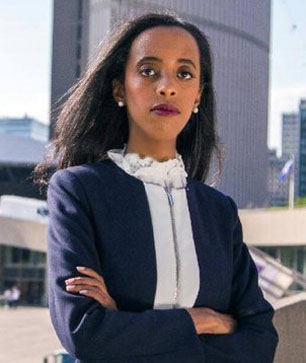
Eritrean-Canadian human rights lawyer Saron Gebresellassi “finished well behind, but encouraged many who feel disenfranchised to vote for the first time.” And she “arrived in a horse drawn carriage for her election-night party”!!!!
* “Eritrean-Canadian human rights lawyer” Saron Gebresellassi “ran a values-based campaign that spoke to racialized Torontonians. She finished well behind, but encouraged many who feel disenfranchised to vote for the first time. She arrived in a horse drawn carriage for her election-night party. Now that’s chutzpah.”
* Despite winning with more than 60% of the city-wide vote, so far the re-elected Mayor John Tory “hasn’t accomplished anything remotely approaching visionary. It’s been back to meat and potatoes issues, like keeping property taxes low, under his watch. Meanwhile, Toronto is headed for a financial iceberg.” (And as the print but not the digital edition of DiMatteo’s piece further explained : “A whopping $22 billion and growing represents the amount in unfunded capital projects” – as former city manager Peter Wallace was stressing before he left this past March.)
* “Ford’s assault on democracy [ie suddenly moving from 44 to 25 council seats in the middle of the campaign] undercut what was shaping up to be the most diverse city government we’d ever seen … Council’s left wing still control about half the 25 seats but just like under Rob Ford, they will have to rely on a handful of councillors who now make up the mushy middle to carry votes over Tory. That will be a trickier proposition this term.” (The Toronto Star may not agree that the left wing “still control about half the 25 seats,” but it probably would second the motion “That will be a trickier proposition this term.”)
(4)Â Finally getting John Tory’s ancestry right
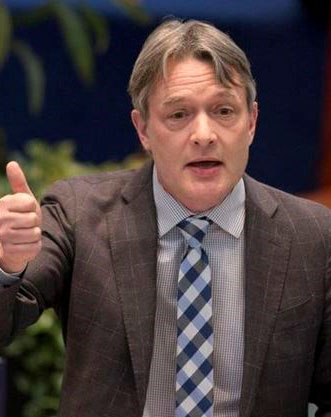
In 2018 yet again Gord Perks, one of Council’s continuing “stalwart progressives” and one of “John Tory’s most strident critics” won re-election comfortably in Ward 4 – Parkdale-High Park.
I have a few times in the past urged (albeit strictly verbally and among friends and colleagues, never in print or digitally – I think) that John Tory is a descendant of an ancient “Tory Toronto” governing elite (aka ruling class, “Family Compact,” etc), stretching back to the early 19th century.
Now that Mayor Tory (2014 – 20??) has democratically won more than 60% of the city-wide vote in the 2018 municipal election, I thought I ought to at least check into this rather vague instinct. It drew on some research I undertook many years ago, for an aspiring article on “Winston Church in Toronto” that no one finally seemed interested in publishing at the time.
More exactly, I discovered that on Saturday, August 17, 1929 the old Globe in Toronto (still several years before its Depression-era merger with the old Mail and Empire) reported on a luncheon address in the banquet room of the new Royal York Hotel the day before, by the visiting Winston Churchill. (Then on a North American tour to occupy some political down time, accompanied by his son, his brother, and his nephew).
In its report the Globe noted that the eminent local businessman John A. Tory had declared : “Perhaps no Empire statesman appealed so strongly to Toronto citizens as Mr. Churchill.”
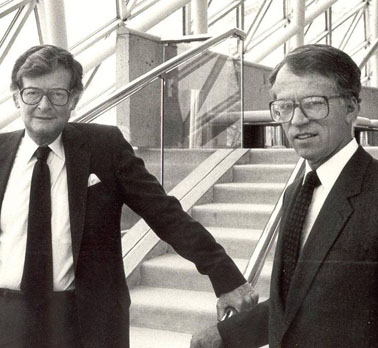
Ken Thomson (left), leader of the international media empire begun by his father, Roy Thomson, and his lawyer and business advisor, John A. Tory (the second, right), late father of today’s Toronto Mayor John H. Tory – “circa 1984”.
I somehow seem to have taken this declaration, made a full century after the heyday of the old Family Compact that the Mackenzie rebellion of 1837 railed against (ultimately leading to the start of Canada’s modern parliamentary democracy in 1848) as a sign that present-day Mayor Tory’s lineage stretches back to the earliest days of a now quite ancient Tory Toronto.
A deft obituary by Sandra Martin in 2011 for the present Mayor Tory’s father, John A. Tory, has now made clear to me that I have been exaggerating the longevity of the current elite Tory family in the Tory Toronto past. (It was btw in 1842 that Charles Dickens, on his first North American tour, wrote to his friend John Forster : “The wild and rabid Toryism of Toronto is, I speak seriously, appalling” – as reported in Forster’s Life of Charles Dickens published in the 1870s.)
Thanks to Ms Martin’s more exhaustive research, I can now report that there are two historic Toronto elite figures named John A. Tory. The second, as it were, is the present mayor John (H.) Tory’s father, who was born in Toronto in 1930, and sadly passed away in 2011. The first is the grandfather of Mayor Tory’s father (or Mayor Tory’s great grandfather). He was born in Nova Scotia in the late 1860s, but “ended up in Toronto as head of the Ontario division of Sun Life Assurance Company.”
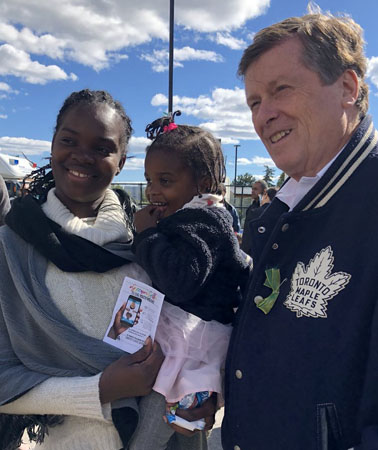
Mayor John Tory and constituents at “the very first Taste of Jane & Finch food truck festival,” late September 2018.
It can only have been this first John A. Tory (in his early 60s at the time) who told the Royal York Hotel audience gathered to hear a touring Winston Churchill in the summer of 1929 : “Perhaps no Empire statesman appealed so strongly to Toronto citizens as Mr. Churchill.”
As Sandra Martin has finally helped me understand as well, it was the first John A’s son (and the present mayor’s grandfather), John S.D. Tory, who founded the business now known as Torys LLP – a “Canadian international corporate law firm with offices in Toronto, Calgary, New York, Montreal and Halifax.”
So … today’s Mayor Tory does not come from quite as old an old Toronto family as I once no doubt somewhat foolishly and even ideologically imagined. But the old Tory Toronto patrician surface that still stands out, even when he’s wearing a Toronto Maple Leafs windbreaker while campaigning among we the unwashed voters, does have venerable enough roots in his great grandfather’s generation
I should very finally say myself that, unlike some very close to me, I share many of the reservations about Mayor Tory’s broad policy approach to Toronto life expressed in Enzo DiMatteo’s NOW magazine report on the 2018 Toronto municipal election.
At the same time, I’d agree that Mayor John H. Tory’s old Toronto patrician democracy of the early 21st century has been a welcome enough relief from the latest appalling wild and rabid Toronto Toryism of the late Rob Ford (may he rest in peace). And it is to Mayor Tory’s credit that during the televised public celebration of his October 22, 2018 victory his adult children warmly explained how he now makes them call him “Your Worship” at family gatherings.
